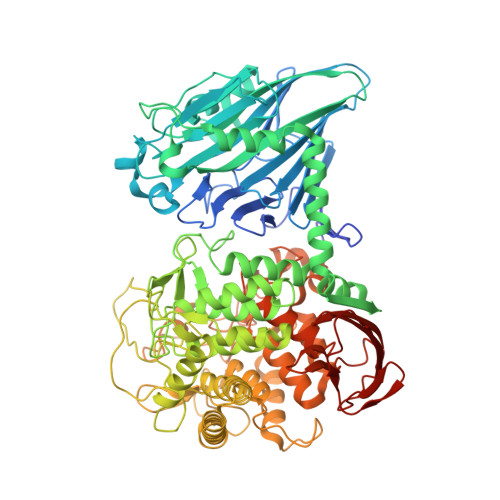Structural dissection of the reaction mechanism of cellobiose phosphorylase.
Hidaka, M., Kitaoka, M., Hayashi, K., Wakagi, T., Shoun, H., Fushinobu, S.(2006) Biochem J 398: 37-43
- PubMed: 16646954
- DOI: https://doi.org/10.1042/BJ20060274
- Primary Citation of Related Structures:
2CQS, 2CQT - PubMed Abstract:
Cellobiose phosphorylase, a member of the glycoside hydrolase family 94, catalyses the reversible phosphorolysis of cellobiose into alpha-D-glucose 1-phosphate and D-glucose with inversion of the anomeric configuration. The substrate specificity and reaction mechanism of cellobiose phosphorylase from Cellvibrio gilvus have been investigated in detail. We have determined the crystal structure of the glucose-sulphate and glucose-phosphate complexes of this enzyme at a maximal resolution of 2.0 A (1 A=0.1 nm). The phosphate ion is strongly held through several hydrogen bonds, and the configuration appears to be suitable for direct nucleophilic attack to an anomeric centre. Structural features around the sugar-donor and sugar-acceptor sites were consistent with the results of extensive kinetic studies. When we compared this structure with that of homologous chitobiose phosphorylase, we identified key residues for substrate discrimination between glucose and N-acetylglucosamine in both the sugar-donor and sugar-acceptor sites. We found that the active site pocket of cellobiose phosphorylase was covered by an additional loop, indicating that some conformational change is required upon substrate binding. Information on the three-dimensional structure of cellobiose phosphorylase will facilitate engineering of this enzyme, the application of which to practical oligosaccharide synthesis has already been established.
Organizational Affiliation:
Department of Biotechnology, University of Tokyo, 1-1-1 Yayoi, Bunkyo-ku, Tokyo 113-8657, Japan.

















